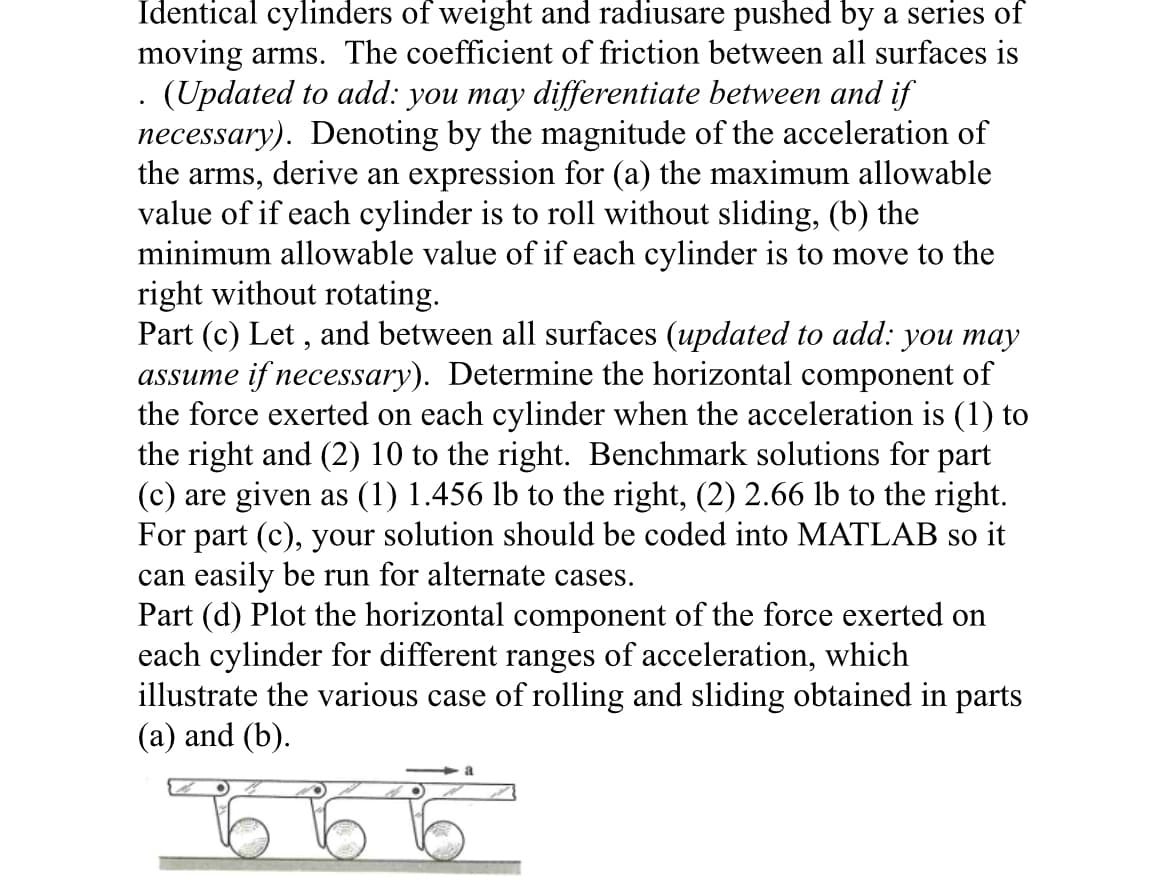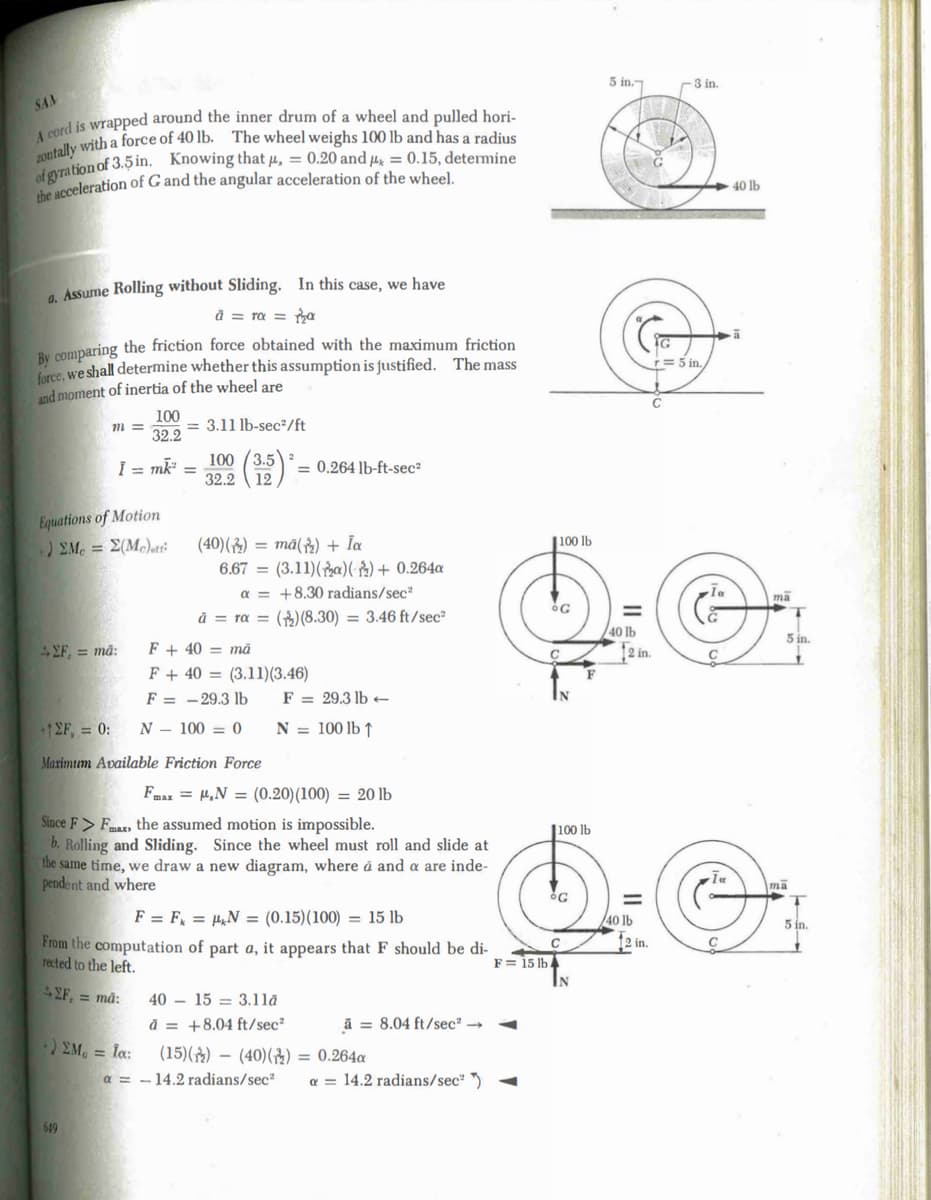Identical cylinders of weight and radiusare pushed by a series of moving arms. The coefficient of friction between all surfaces is . (Updated to add: you may differentiate between and if necessary). Denoting by the magnitude of the acceleration of the arms, derive an expression for (a) the maximum allowable value of if each cylinder is to roll without sliding, (b) the minimum allowable value of if each cylinder is to move to the right without rotating. Part (c) Let, and between all surfaces (updated to add: you may assume if necessary). Determine the horizontal component of the force exerted on each cylinder when the acceleration is (1) to the right and (2) 10 to the right. Benchmark solutions for part (c) are given as (1) 1.456 lb to the right, (2) 2.66 lb to the right. For part (c), your solution should be coded into MATLAB so it can easily be run for alternate cases. Part (d) Plot the horizontal component of the force exerted on each cylinder for different ranges of acceleration, which illustrate the various case of rolling and sliding obtained in parts (a) and (b).
Identical cylinders of weight and radiusare pushed by a series of moving arms. The coefficient of friction between all surfaces is . (Updated to add: you may differentiate between and if necessary). Denoting by the magnitude of the acceleration of the arms, derive an expression for (a) the maximum allowable value of if each cylinder is to roll without sliding, (b) the minimum allowable value of if each cylinder is to move to the right without rotating. Part (c) Let, and between all surfaces (updated to add: you may assume if necessary). Determine the horizontal component of the force exerted on each cylinder when the acceleration is (1) to the right and (2) 10 to the right. Benchmark solutions for part (c) are given as (1) 1.456 lb to the right, (2) 2.66 lb to the right. For part (c), your solution should be coded into MATLAB so it can easily be run for alternate cases. Part (d) Plot the horizontal component of the force exerted on each cylinder for different ranges of acceleration, which illustrate the various case of rolling and sliding obtained in parts (a) and (b).
Elements Of Electromagnetics
7th Edition
ISBN:9780190698614
Author:Sadiku, Matthew N. O.
Publisher:Sadiku, Matthew N. O.
ChapterMA: Math Assessment
Section: Chapter Questions
Problem 1.1MA
Related questions
Question
Only need A, B, and C please.

Transcribed Image Text:Identical cylinders of weight and radiusare pushed by a series of
moving arms. The coefficient of friction between all surfaces is
. (Updated to add: you may differentiate between and if
necessary). Denoting by the magnitude of the acceleration of
the arms, derive an expression for (a) the maximum allowable
value of if each cylinder is to roll without sliding, (b) the
minimum allowable value of if each cylinder is to move to the
right without rotating.
Part (c) Let, and between all surfaces (updated to add: you may
assume if necessary). Determine the horizontal component of
the force exerted on each cylinder when the acceleration is (1) to
the right and (2) 10 to the right. Benchmark solutions for part
(c) are given as (1) 1.456 lb to the right, (2) 2.66 lb to the right.
For part (c), your solution should be coded into MATLAB so it
can easily be run for alternate cases.
Part (d) Plot the horizontal component of the force exerted on
each cylinder for different ranges of acceleration, which
illustrate the various case of rolling and sliding obtained in parts
(a) and (b).

Transcribed Image Text:SAM
A cord is wrapped around the inner drum of a wheel and pulled hori-
zontally with a force of 40 lb. The wheel weighs 100 lb and has a radius
of gyration of 3.5 in. Knowing that μ, = 0.20 and = 0.15, determine
the acceleration of G and the angular acceleration of the wheel.
a. Assume Rolling without Sliding. In this case, we have
à = rα = ₂a
By comparing the friction force obtained with the maximum friction
force, we shall determine whether this assumption is justified. The mass
and moment of inertia of the wheel are
111 =
- ΣF, = md:
Equations of Motion
+) EMc = Σ(Me)ett:
100
32.2
I = mk²
649
= 3.11 lb-sec²/ft
+) EM, = la:
=
100 3.5
32.2 12
(40)(2) ma() + Ia
6.67= (3.11)(a)()+ 0.264a
a +8.30 radians/sec²
à ra = () (8.30)= 3.46 ft/sec²
mā
F + 40
F+40
F= 29.3 lb
N
100 0
+1EF, = 0:
Maximum Available Friction Force
= 0.264 lb-ft-sec²
(3.11)(3.46)
Fmax = μ,N= (0.20) (100) = 20 lb
Since F> Fmax, the assumed motion is impossible.
b. Rolling and Sliding. Since the wheel must roll and slide at
the same time, we draw a new diagram, where a and a are inde-
pendent and where
F = 29.3 lb-
N = 100 lb ↑
F = F₁ = ₂N = (0.15) (100) = 15 lb
From the computation of part a, it appears that F should be di-
rected to the left.
42F, = må:
40 15 3.11a
à +8.04 ft/sec²
à 8.04 ft/sec²
(40) () = 0.264a
(15))
a = 14.2 radians/sec² a = 14.2 radians/sec²
100 lb
F= 15 lb
G
IN
100 lb
OG
с
5 in.
IN
=
40 lb
2 in.
3 in.
r= 5 in.
C
40 lb
5.0₂
40 lb
12 in.
ā
mā
5 in.
ma
5 in.
Expert Solution
This question has been solved!
Explore an expertly crafted, step-by-step solution for a thorough understanding of key concepts.
This is a popular solution!
Trending now
This is a popular solution!
Step by step
Solved in 4 steps with 4 images

Knowledge Booster
Learn more about
Need a deep-dive on the concept behind this application? Look no further. Learn more about this topic, mechanical-engineering and related others by exploring similar questions and additional content below.Recommended textbooks for you

Elements Of Electromagnetics
Mechanical Engineering
ISBN:
9780190698614
Author:
Sadiku, Matthew N. O.
Publisher:
Oxford University Press

Mechanics of Materials (10th Edition)
Mechanical Engineering
ISBN:
9780134319650
Author:
Russell C. Hibbeler
Publisher:
PEARSON

Thermodynamics: An Engineering Approach
Mechanical Engineering
ISBN:
9781259822674
Author:
Yunus A. Cengel Dr., Michael A. Boles
Publisher:
McGraw-Hill Education

Elements Of Electromagnetics
Mechanical Engineering
ISBN:
9780190698614
Author:
Sadiku, Matthew N. O.
Publisher:
Oxford University Press

Mechanics of Materials (10th Edition)
Mechanical Engineering
ISBN:
9780134319650
Author:
Russell C. Hibbeler
Publisher:
PEARSON

Thermodynamics: An Engineering Approach
Mechanical Engineering
ISBN:
9781259822674
Author:
Yunus A. Cengel Dr., Michael A. Boles
Publisher:
McGraw-Hill Education

Control Systems Engineering
Mechanical Engineering
ISBN:
9781118170519
Author:
Norman S. Nise
Publisher:
WILEY

Mechanics of Materials (MindTap Course List)
Mechanical Engineering
ISBN:
9781337093347
Author:
Barry J. Goodno, James M. Gere
Publisher:
Cengage Learning

Engineering Mechanics: Statics
Mechanical Engineering
ISBN:
9781118807330
Author:
James L. Meriam, L. G. Kraige, J. N. Bolton
Publisher:
WILEY